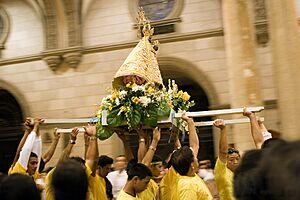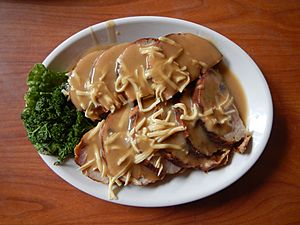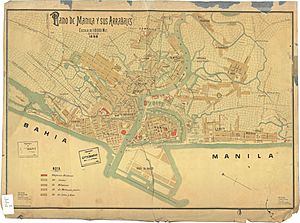Spanish influence on Filipino culture facts for kids
The Spanish influence on Filipino culture is very deep. It started when the Spanish East Indies were ruled from Mexico City and Madrid. Many customs and traditions in the Philippines today come from Spanish and Mexican influences.
Contents
- Background of Spanish Influence
- Life Before Spanish Arrival
- Language Changes and Spanish Words
- How the Philippines Got Its Name
- People of the Philippines
- Religion in the Philippines
- Arts, Literature, and Music
- Filipino Cuisine and Spanish Flavors
- Business and Trade Connections
- Images for kids
- See Also
Background of Spanish Influence
Spanish people first settled in the Philippines in the 1500s. The islands were part of New Spain (Mexico) until Mexico became independent in 1821. After that, Spain ruled the islands directly.
The Spanish explorer Miguel López de Legazpi came from New Spain. He started the first Spanish settlement in Cebu in 1565. Later, in 1571, he made Manila the capital of the Spanish East Indies. The Philippines got its name from King Philip II of Spain.
Filipinos sometimes call Spaniards "Kastila." This name comes from the old Kingdom of Castile in Spain. Some Filipinos today have Spanish ancestors. These are people from Spain and Mexico who came during the time Spain ruled the islands.
Life Before Spanish Arrival
Before the Spanish came, some groups on the islands lived separately. But many others grew into states that traded a lot with people from East and South Asia. These included people from India, China, Japan, and other Austronesian islands like the Malay archipelago.
Around 1000 years ago, small port towns grew into powerful sea states. These states were made of independent villages called barangays. They were either on their own or worked with bigger nations. These bigger nations were often Malay sea empires led by Datus or Indian-influenced kingdoms led by Rajahs.
Language Changes and Spanish Words
Philippine Spanish is a type of Spanish spoken in the Philippines. It is a dialect of the Spanish language.
Chavacano is a special language based on Spanish. It is spoken in the Zamboanga Peninsula (where it's an official language), Davao, Cotabato in Mindanao, and Cavite in Luzon.
Today, Filipinos speak many different languages. These include Cebuano, Tagalog, Ilocano, Ilonggo, and Bikolano. Most of these are Austronesian languages. They also have many Spanish words mixed in. Even with years of Spanish rule, the Philippines kept most of its own languages and culture.
The most common languages in the Philippines today are English and Filipino. Filipino is the national language and is based on Tagalog. Spanish used to be an official language until 1986. Now, very few people speak Spanish as their first language.
However, former President Gloria Macapagal Arroyo, who spoke Spanish, brought back Spanish classes in public schools.
How the Philippines Got Its Name
The name of the Philippines comes from King Philip II of Spain. The Spanish explorer Ruy López de Villalobos gave the islands of Samar and Leyte the name "Las Islas Felipinas" (The Philippine Islands) in 1543. During the time Spain ruled, the name Felipinas (Philippines) became the official name.
Many provinces in the Philippines have Spanish names. Some examples are Nueva Vizcaya, Nueva Ecija, Laguna, Isabela, Quirino, Aurora, La Union, Marinduque, Antique, Negros Occidental, Negros Oriental, and Valle de Compostela.
Many cities and towns also have Spanish names. These include Medellin, La Libertad, Naga, Camarines Sur (once called Nueva Cáceres), Las Piñas, Prosperidad, Isabela, Sierra Bullones, Angeles, La Paz, Esperanza, Buenavista, Pilar, La Trinidad, Garcia Hernandez, Trece Martires, and Los Baños. Many are named after saints, like San Fernando, Santa Rosa, San Isidro, San José, San Juan, and San Pablo. Others are named after places in Spain, such as Madrid, Santander, Toledo, Cádiz, Valencia, Murcia, Lucena, and Pamplona.
Some native Filipino names are also spelled using Spanish writing rules, like Cagayán de Oro, Parañaque, and Cebú.
Filipino Spanish Surnames and Their History
Having a Spanish-sounding last name does not always mean someone has Spanish ancestors in the Philippines. These names came from the Spanish rule of the islands and their system for naming people.
After the Spanish arrived, many early Christian Filipinos took religious names or names of saints. This is why many people have last names like "de Los Santos" ("of the Saints"), "de la Cruz" ("of the Cross"), "del Rosario" ("of the Rosary"), "Bautista" ("Baptist"), and "de Jesus" ("of Jesus").
On November 21, 1849, the Spanish Governor-General, Narciso Clavería, ordered a new system for giving out last names to Filipinos. This led to the Catálogo alfabético de apellidos ("Alphabetical Catalogue of Surnames"). This book listed Spanish versions of Chinese and Filipino words, names, and numbers. Last names of Spanish nobles were not allowed. Many names that came from this system are not common in Spanish-speaking countries because they were made from original Filipino or Chinese words. This new system also stopped the Filipino custom of brothers and sisters having different last names.
People of the Philippines
Filipinos are part of the Austronesian peoples group from Southeast Asia. The people of the Philippine Islands are closely related to their neighbors in Malaysia and Indonesia. Over thousands of years, people from different parts of Asia, including Austronesians and Chinese, came to the islands. This created a mix of cultures and people. Today, Filipinos are a blend of many different groups.
Religion in the Philippines
The Philippines is one of only two countries in Asia where most people are Christian. The other is East Timor. About 81% of Filipinos are Catholic, and 11% belong to other Christian groups. About 5.6% are Muslim, and 2% follow other religions or no religion.
Filipino families often have altars at home, like in the Spanish tradition. These altars are decorated with Catholic images, flowers, and candles. During fiestas (festivals), most communities have church services and religious parades to honor a patron saint. They also have funfairs, concerts, and enjoy many Filipino foods.
Festivities and Holidays
All major Christian holidays are celebrated as official national holidays in the Philippines. Spanish culture and Christianity have greatly shaped Filipino customs and traditions.
Every year on the third Sunday of January, the Philippines celebrates the "Santo Niño" (Holy Child Jesus) festival. The biggest celebration is in Cebu City.
Here are some important holidays:
- January 1 – New Year's Day (Bagong Taon)
- March or April – Semana Santa (Holy Week or Easter).
- October 31 to November 2 – Day of the Dead, Araw ng mga Kaluluwa (All Souls' Day), and Todos Los Santos (All Saints' Day). Families spend these three days and nights visiting the graves of their ancestors. They show respect and honor their relatives by feasting, decorating graves, and praying.
- December 24 – Nochebuena (The Good Night or Christmas Eve)
- December 25 – Christmas (Pasko)
Arts, Literature, and Music
Spanish influence on Filipino arts, literature, and music mixes with local traditions. Folk dance, music, and stories from the Spanish period are still important today. These were brought from Spain in the 1500s and have been a big part of Filipino culture for centuries.
Filipino Cuisine and Spanish Flavors
Filipino food shows influences from Spanish, Mexican, and Asian cooking.
Some popular dishes with Spanish roots include:
- Afritada
- Albóndigas
- Arroz a la valenciana
- Arroz caldo
- Bistek
- Brazo de Mercedes
- Caldereta
- Champorado
- Galantina
- Chicharrón
- Chorizo
- Dulce de membrillo
- Dulce de leche
- Empanadas
- Estufado
- Ensaymadas
- Escabeche
- Espasol
- Flan
- Jamonada or Endulzado
- Galletas
- Jamón
- Lechón
- Longaniza
- Lúgaw
- Maíz con hielo
- Mantequilla
- Mazapán
- Mechado
- Menudo
- Natilla
- Paella
- Pan de sal
- Pastel de lengua
- Pastillas de leche
- Pescado
- Picadillo
- Pionono
- Putsero
- Polvorón
- Quezo de Bola
- Relleno
- Tamale
- Torta del cielo
- Tortas
- Tortilla quesada
- Tocino
- Tocino del cielo
- Turrones de Casuy
Business and Trade Connections
The Philippine Chamber of Commerce and Industry (PCCI) is very important for the country's economy and society. This group started a long time ago, in the 1890s, as the Cámara de Comercio de Filipinas. It included many Spanish companies, like the Compañia General de Tabacos de Filipinas and Fábrica de Cerveza San Miguel, along with Filipino companies.
In the first half of the 1900s, trade with Spain and Latin American countries decreased. This was because the United States ruled the Philippines and then World War II happened. However, trade between Spain and Latin American nations grew again towards the end of the century. In 1998, the Philippines celebrated 100 years of independence. This created new chances for Spanish and Filipino businesses to connect again.
Images for kids
See Also
 In Spanish: Influencia hispánica en la cultura filipina para niños
In Spanish: Influencia hispánica en la cultura filipina para niños
- Hispanic culture
- Culture of the Philippines
- Latin Union
- Philippines education during Spanish rule







